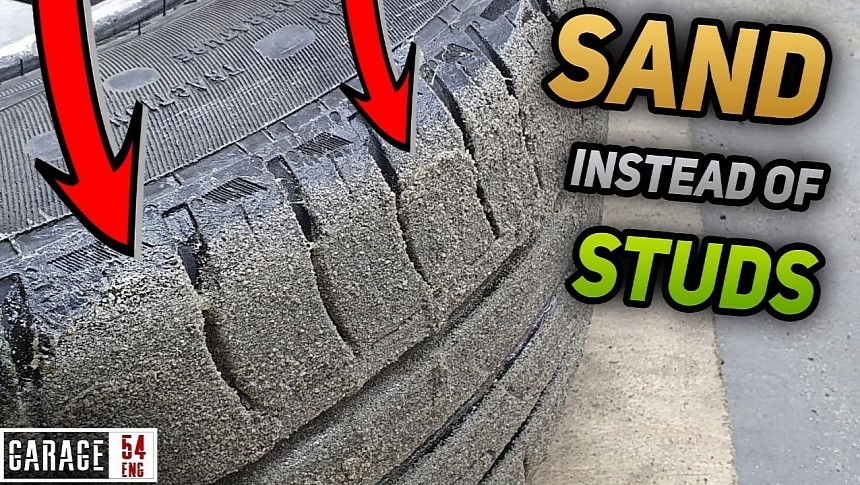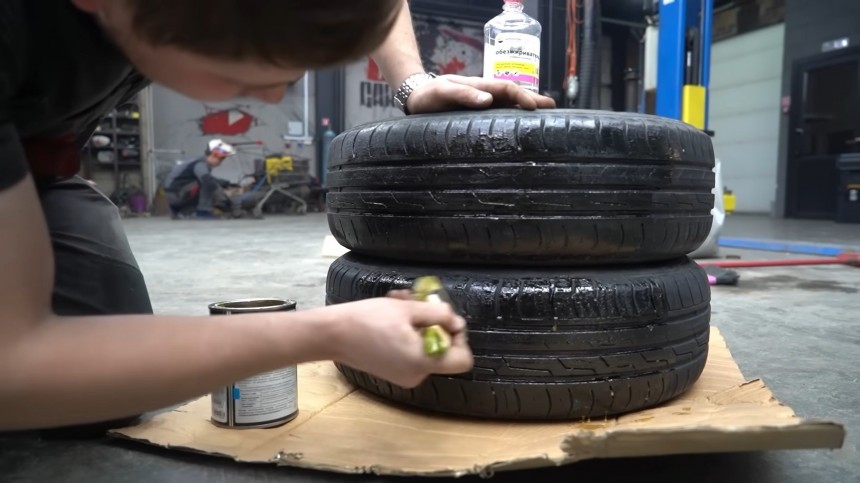When the going gets tough, the tough lose grip and get sideways because it’s winter, the roads are covered in snow and ice, and it’s cold. The car is on summer tires, and we’re talking about Russia. And precisely for that reason alone, there’s a workaround – sometimes it’s genius, sometimes a crazy YouTube Video. Here’s the riddle: what’s the solution for making summer tires grip on ice, according to the YouTube Academy of ‘Don’t Try This on Public Roads’ (Siberian Branch)?
Let’s face it like gearheads: we’ve all been there at one point (or several): winter drops in without forewarning, and the car is still on summer tires. (We won’t go the way of the old times when a single set of tires was good enough through all four seasons). With today’s rubber compounds increasingly more dedicated to meeting stricter criteria for fuel economy and whatnot, a one-size-fits-all kind of product is impossible (or at least not economically feasible).
Thankfully, there’s a makeshift quick fix for emergencies (isn’t there always one?), and it comes from Russia. The largest country in the world is in no shortage of either winter, cheat code solutions for every situation imaginable, or the people to test it. This time, the proposed alternative to classic winter tires is summer tires with a sand layer to improve grip on slippery surfaces.
There’s a city in Southern Siberia that is home to a gang of smart Alecs who like to constantly challenge the practical limits and possibilities of everything car-related. This time of the year, their city is covered in winter – and I mean proper Russian winter, not the climate-change global warming bad joke environmentalists like to go mental over. The perfect environment for Garage 54 to sprout new quirky ideas.
Winter tires are a long-since commonality in Russia, make no mistake about it, but where’s the fun in doing things the way the government advises, expects, mandates, or forces one to do? The clever wrench-yielding Siberians have tested several options for getting around in winter (with a car!). Their latest video is centered around an age-old idea: making the contact surface of an ordinary summer tire more adherent by adding a coarser substance over it.
However, they went for sand – which seems counterintuitive at first glance since sand isn’t the best surface to drive over when encountered in its natural form in the wild. The tiny particles (essentially downsized pebbles) are awfully unpredictable and devastatingly wavy when a wheel rolls over them. However, put it on a firm, stable surface, and sand becomes a rasp that clings to almost anything. That’s how sandpaper works.
The Russians have fiddled with putting a sandpaper belt on tires in the past, but that didn’t work out due to the ‘paper’ factor (the abrasive device was quickly clogged with snow and lost all adherent properties - watch the second video for that). This time, they went one step further and glued the sand onto the rubber – with proper glue applied (by hand) on a cured, cleaned, and degreased summer tire.
Amazingly, their idea did return positive results. The landmark was set by driving a summer-tire-equipped Toyota Camry sedan over an icy surface (on a closed course in a controlled environment, I must stress out). The points of reference are reasonably straightforward: accelerate to 25 mph (40 kph) from a standstill and then brake back to naught.
It took 27 seconds for the front-wheel drive car to get up to speed in the first run, and the stopping distance was 45 meters (148 feet). With the sand-coated summer tires on, the car reached the same speed in a blistering 17 seconds and then came to a dead stop at around 38 meters (125 feet). The second attempt delivered mixed results, with 20 seconds for the acceleration test and 35 meters (115 feet) for the brake.
After that, the wheels began losing their grip, given the forces exerted onto the thin layer of sand-glue mixture. For proper comparison purposes, a set of winter tires was tested. It came back with relatively close figures to the sandy invention of Garage 54: 15 seconds for the 0-25 mph sprint and 35 meters for the brake distance. Bear in mind that the winter tires are studded (for driving mostly over ice), so the sand experiment is actually a success.
Many factors must be accounted for when assessing the Novosibirsk mechanics’ trial session results. The coarseness of the sand, the stickiness of the glue, the driving surface, the car’s driving aids, the driver’s particular style of accelerating and braking, and so on. But at the end of the day, their idea isn’t half bad, and it has been put to work by other like-minded people worldwide.
However, using a regular brush to apply a thin glue film over a summer tire and then rolling it around in fine-grain, blow-torch-dried sand is not recommended for braving the snow. Past experiments have proposed recapped tires with ground walnut shells mixed into the rubber formula and offered satisfactory experiences to customers.
Thankfully, there’s a makeshift quick fix for emergencies (isn’t there always one?), and it comes from Russia. The largest country in the world is in no shortage of either winter, cheat code solutions for every situation imaginable, or the people to test it. This time, the proposed alternative to classic winter tires is summer tires with a sand layer to improve grip on slippery surfaces.
There’s a city in Southern Siberia that is home to a gang of smart Alecs who like to constantly challenge the practical limits and possibilities of everything car-related. This time of the year, their city is covered in winter – and I mean proper Russian winter, not the climate-change global warming bad joke environmentalists like to go mental over. The perfect environment for Garage 54 to sprout new quirky ideas.
However, they went for sand – which seems counterintuitive at first glance since sand isn’t the best surface to drive over when encountered in its natural form in the wild. The tiny particles (essentially downsized pebbles) are awfully unpredictable and devastatingly wavy when a wheel rolls over them. However, put it on a firm, stable surface, and sand becomes a rasp that clings to almost anything. That’s how sandpaper works.
The Russians have fiddled with putting a sandpaper belt on tires in the past, but that didn’t work out due to the ‘paper’ factor (the abrasive device was quickly clogged with snow and lost all adherent properties - watch the second video for that). This time, they went one step further and glued the sand onto the rubber – with proper glue applied (by hand) on a cured, cleaned, and degreased summer tire.
It took 27 seconds for the front-wheel drive car to get up to speed in the first run, and the stopping distance was 45 meters (148 feet). With the sand-coated summer tires on, the car reached the same speed in a blistering 17 seconds and then came to a dead stop at around 38 meters (125 feet). The second attempt delivered mixed results, with 20 seconds for the acceleration test and 35 meters (115 feet) for the brake.
After that, the wheels began losing their grip, given the forces exerted onto the thin layer of sand-glue mixture. For proper comparison purposes, a set of winter tires was tested. It came back with relatively close figures to the sandy invention of Garage 54: 15 seconds for the 0-25 mph sprint and 35 meters for the brake distance. Bear in mind that the winter tires are studded (for driving mostly over ice), so the sand experiment is actually a success.
However, using a regular brush to apply a thin glue film over a summer tire and then rolling it around in fine-grain, blow-torch-dried sand is not recommended for braving the snow. Past experiments have proposed recapped tires with ground walnut shells mixed into the rubber formula and offered satisfactory experiences to customers.









































